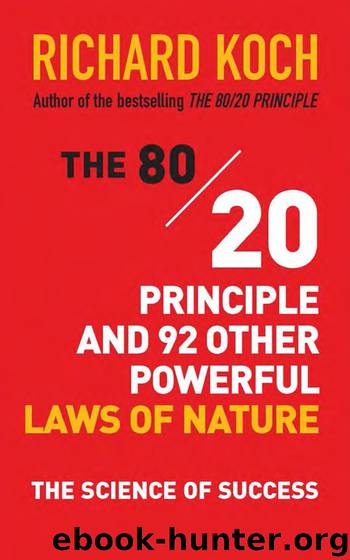The 8020 Principle and 92 Other Powerful Laws of Nature by Richard Koch

Author:Richard Koch
Language: eng
Format: epub
Publisher: Nicholas Brealey Publishing
Published: 2014-04-23T04:00:00+00:00
Time heresy: time is abundant, time is available
How can we change our mental map of time? Here are a couple of related thoughts that are profoundly and demonstrably true, and that invalidate our usual view of time. First, there is no shortage of time; rather, we are positively awash with it. I may need some time—which we enjoy in abundance!—to persuade you of this, so I will pass swiftly on to point two, which I think will be accepted more readily: very little of what a firm (and by inference, an executive) does adds a great deal of value to customers. Most of the value that is added comes in short bursts, oases of productivity, surrounded by a desert of low value processes. Einstein is an extreme example. How much time did he need to devise E = mal What was the value/time relationship? Not infinite, but a very big number!
This second point has actually been proved quantitatively by a very large number of surveys, especially those associated in the late 1980s and the 1990s with the techniques of time-based competition and reengineering (also known as business process reengineering or BPR). I don’t want to go into techniques yet, or in much detail at all, because I want you to focus on the principle, on your mental map, on how you think about business. But Mark Blaxill and Tom Hout of the Boston Consulting Group sum up their evidence from a huge amount of client work as follows:
Typically, less than 10 percent of the total time devoted to any work in an organization is truly value-added. The rest is wasted because of unnecessary steps or unbalanced operations.2
What happens is that the high-value work takes a small amount of time, and there are huge gaps before high-value service to customers is resumed, because firms organize themselves to follow their own procedures instead of having the work flow dictated by the customer’s needs. Most of the time a product or service is being produced is time spent waiting, usually for some other executive or part of the organization (and occasionally customers themselves) to respond or do something. Delays come from procedural constraints—always able to be eliminated—quality problems—ditto—and structural difficulties, which can be dealt with by redirecting the flow of work; that is, by changing the structure. Very rarely are firms’ structures designed with the objective of speeding the product or service to customer. When they are, there are nearly always large cost and quality improvements as by-products.
So let’s come back to the first point: time is plentiful. I know this sounds nonsense, or at least paradoxical. We’re all stressed, we’re all busy, we’re all interrupted, we’re all trying to ‘manage’ our time better, to dole out such a scarce resource as parsimoniously as possible. Yet herein lies the problem, and the answer.
Hold on, relax, and think for a moment. If only 10 percent of our time is really used to great effect, it follows that 90 percent isn’t, and that this time is available for high-value activity.
Download
This site does not store any files on its server. We only index and link to content provided by other sites. Please contact the content providers to delete copyright contents if any and email us, we'll remove relevant links or contents immediately.
The Compound Effect by Darren Hardy(8869)
Tools of Titans by Timothy Ferriss(8303)
Nudge - Improving Decisions about Health, Wealth, and Happiness by Thaler Sunstein(7654)
Win Bigly by Scott Adams(7133)
Deep Work by Cal Newport(6961)
Rich Dad Poor Dad by Robert T. Kiyosaki(6506)
Principles: Life and Work by Ray Dalio(6296)
Pioneering Portfolio Management by David F. Swensen(6253)
The Barefoot Investor by Scott Pape(5719)
Digital Minimalism by Cal Newport;(5700)
Grit by Angela Duckworth(5553)
The Slight Edge by Jeff Olson(5376)
Discipline Equals Freedom by Jocko Willink(5333)
The Motivation Myth by Jeff Haden(5174)
You Are a Badass at Making Money by Jen Sincero(4891)
The Four Tendencies by Gretchen Rubin(4575)
Eat That Frog! by Brian Tracy(4479)
The Confidence Code by Katty Kay(4217)
Bullshit Jobs by David Graeber(4136)
